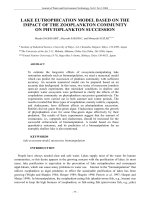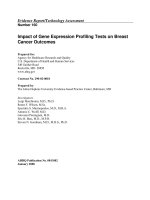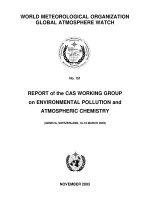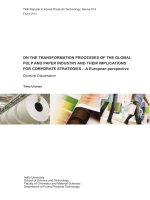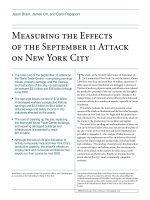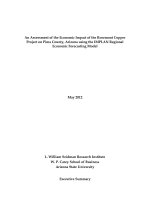Impact of the global forest industry on atmospheric greenhouse gases potx
Bạn đang xem bản rút gọn của tài liệu. Xem và tải ngay bản đầy đủ của tài liệu tại đây (515.98 KB, 86 trang )
Cover photos:
Natural and planted forest (Veracel/N. Souza); paper industry (Bahia Specialty Cellulose)
Impact of the global forest
industry on atmospheric
greenhouse gases
Reid Miner
Vice President – Sustainable Manufacturing
National Council for Air and Stream Improvement (NCASI)
Research Triangle Park, North Carolina, United States of America
food and agriculture organization of the united nations
Rome, 2010
FAO
FORESTRY
PAPER
159
The designations employed and the presentation of material in this information product do
not imply the expression of any opinion whatsoever on the part of the Food and Agriculture
Organization of the United Nations (FAO) concerning the legal or development status of
any country, territory, city or area or of its authorities, or concerning the delimitation of its
frontiers or boundaries. The mention of specific companies or products of manufacturers,
whether or not these have been patented, does not imply that these have been endorsed or
recommended by FAO in preference to others of a similar nature that are not mentioned.
The views expressed in this information product are those of the author(s) and do not
necessarily reflect the views of FAO.
ISBN 978-92-5-106560-0
All rights reserved. FAO encourages the reproduction and dissemination of material in this
information product. Non-commercial uses will be authorized free of charge, upon request.
Reproduction for resale or other commercial purposes, including educational purposes,
may incur fees. Applications for permission to reproduce or disseminate FAO copyright
materials, and all queries concerning rights and licences, should be addressed by e-mail
to or to the Chief, Publishing Policy and Support Branch, Office of
Knowledge Exchange, Research and Extension, FAO, Viale delle Terme di Caracalla, 00153
Rome, Italy.
© FAO 2010
iii
Contents
Foreword
Acknowledgements
Acronyms and abbreviations
Summary
1. Introduction
vii
viii
ix
x
1
Overview of the global forest products industry
1
Forest industry and the global carbon cycle
5
2. The role of forests in sequestering and storing carbon
7
Carbon in the world’s forests
7
Effects of the forest products industry on forest ecosystem carbon
8
3. Carbon in forest products
13
4. Manufacturing-related emissions
17
Direct emissions from primary manufacturing
17
Direct emissions from final product manufacturing
19
Direct emissions from management of mill wastes
20
Emissions associated with purchased electricity
21
5. Other cradle-to-gate emissions from the forest products value chain
23
Emissions associated with wood production
23
Upstream emissions associated with non-wood inputs and fossil fuels
23
Emissions associated with transporting raw materials and fuels
24
6. Emissions from the gate-to-grave portion of the value chain
27
Transport of products to consumers
27
Emissions associated with product use
27
Emissions associated with transporting used products to the end
of the life cycle
27
Emissions associated with the end of the life cycle
27
7. Emissions avoided elsewhere in society owing to forest industry
activities
29
Methane emissions that would occur if recovered paper products were
sent to landfills
29
Benefits of burning non-recyclable discarded products at the end
of the life cycle
30
Impacts of the forest industry’s exports of low greenhouse gas intensity
electricity and steam
30
Societal benefits of using wood-based building materials instead of more
greenhouse gas intensive alternatives
31
The value of markets for wood as an incentive for keeping land in forest
32
iv
8. The global forest industry’s overall carbon and greenhouse gas profile
33
9. The potential for forest-based materials to displace fossil fuels
37
10. IPCC’s findings regarding the mitigation potential of forests
39
“In the long term…”
39
“…a sustainable forest management strategy…”
39
“…aimed at maintaining or increasing forest carbon stocks…”
40
“…while producing an annual sustained yield of timber, fibre or energy
from the forest…”
40
“…will generate the largest sustained mitigation benefit.”
40
11. Key findings
43
References
45
Annex 1. Calculations
49
Carbon storage in paper products in use and in landfills
49
Carbon storage in wood products in use and in landfills
53
Emissions from manufacturing
57
Emissions associated with purchased electricity
57
Upstream emissions associated with non-wood inputs and fossil fuels
61
Transport-related emissions
62
End-of-life emissions
63
Annex 2. An overview of harvested wood products accounting
in national greenhouse gas inventories
67
The major options
68
Concerns about HWP accounting
69
Outlook
71
v
Figures
1
Economic impact of the global forest products industry (2006)
1
2
Trends in production of forest products, as fractions of 1990 production
2
3
Global production of sawnwood, 2007
2
4
Global production of wood-based panels, 2007
3
5
Global production of paper and paperboard, 2007
3
6
Global production of roundwood, 2007
4
7
Types of planted forests, 2005
9
8
Uses of planted forests
10
9
Growth in global stocks of stored carbon (estimated long-term
storage of carbon in products sold in 2007)
15
10
Greenhouse gas intensity of forest products manufacturing
18
11
Comparison of conventional and CHP generation systems
21
12
Greenhouse gas emissions for the global forest products sector
33
13
Factors in increased pine plantation productivity in the southeastern
United States
38
1
Industrial reliance on biomass energy
17
2
Selected studies examining the emissions from final product
manufacturing
19
3
Greenhouse gas emission factors associated with forest management
23
4
Upstream emissions associated with fossil fuels and chemical inputs
in manufacturing
24
5
Transport-related emissions in the forest products industry value chain
25
6
Estimated emissions and sequestration in the global forest products
industry value chain, circa 2006/2007
34
Summary of selected avoided emissions associated with the forest
products value chain
35
8
Potential biomass supply in 2050
37
A-1
Countries responsible for 90 percent of paper and paperboard
consumption
50
A-2 Calculation of the carbon in paper remaining in use and in discards
to landfills
51
A-3 IPCC’s methane correction factors
51
A-4 Calculation of carbon stored in paper and paperboard products
in landfills
52
A-5 Countries accounting for 90 percent of global wood products
consumption
54
A-6 Calculation of carbon stored in wood products in use and in discards
to landfills
55
A-7 Calculation of carbon stored in wood products in landfills
56
A-8 Emissions associated with purchased electricity at paper and
paperboard mills
58
A-9 Emissions associated with purchased electricity at timber mills
59
A-10 Emissions associated with purchased electricity at panel plants
60
A-11 Upstream emissions associated with chemicals used in producing
paper and paperboard
61
Tables
7
vi
A-12 Upstream emissions associated with chemicals used in producing
wood-based panels
61
A-13 Upstream emissions associated with fossil fuel use at forest products
manufacturing facilities
62
A-14 Final calculation of emissions associated with international transport
63
A-15 Calculation of transport emissions related to domestic transport
63
A-16 Emissions from burning used products at the end of the life cycle, 2007
64
A-17 Methane emissions from paper and paperboard disposed of in landfills
64
A-18 Methane emissions from wood products disposed of in landfills
65
vii
Foreword
FAO and the International Council of Forest and Paper Associations (ICFPA)
commissioned this study at the request of the forty-ninth session of the Advisory
Committee on Pulp and Wood Products (ACPWP), held in Backubung, South Africa
in June 2008. It outlines the global roundwood production, pulp and paper, and wood
processing industry’s contribution to climate change mitigation and aims to raise the
industry’s profile in international negotiations on global warming.
Over the years, climate change has become a priority issue for the global environment.
Recently, the focus of the global climate change agenda has started to shift from carbon
sequestration to low carbon emission products and technologies, in which forest
industries should play a crucial role. Stable demand for forest products is one of the
most important factors in avoiding forest land-use change and maintaining stable forest
cover to withstand global warming.
FAO does not necessarily share or support all of the statements in this report.
However, we think it is an important attempt to present the climate profile of modern
forest management and industries impartially, based on solid facts and figures. We hope
that the report will open avenues for further clarification, discussion, findings and
solutions.
Michael Martin
Director, Forest Economics and Policy Division
Forestry Department, FAO
viii
Acknowledgements
FAO wishes to thank the author and all contributors and reviewers of this study,
particularly:
Teresa Presas, President of the International Council of Forest and Paper
Associations (ICFPA) and Managing Director of the Confederation of European
Paper Industries (CEPI);
Bernard De Galembert, Forest and Research Director, Confederation of European
Paper Industries (CEPI);
Susan Braatz, Rikiya Konishi, Andrea Perlis and Simmone Rose, FAO;
the Advisory Committee on Pulp and Wood Products (ACPWP);
the Confederation of European Paper Industries (CEPI);
the International Council of Forest and Paper Associations (ICFPA);
the National Council for Air and Stream Improvement (NCASI).
ix
Acronyms and abbreviations
ACEEE
ACPWP
BSI
CEPI
CHP
CO2
CoC
EJ
EU
FICAT
FSC
GDP
Gha
GJ
Gt
GW
HWP
ICFPA
IEA
IFC
IIED
IPCC
ICFPA
LHV
MCF
MW
NCASI
OECD
PAS
PEFC
PPP
UNFCCC
USEPA
WBCSD
WRI
American Council for an Energy-Efficient Economy
Advisory Committee on Pulp and Wood Products
British Standards Institution
Confederation of European Paper Industries
combined heat and power
carbon dioxide
chain-of-custody certificate
exajoule
European Union
Forest Industry Carbon Assessment Tool
Forest Stewardship Council
gross domestic product
gigahectare
gigajoule
gigatonne
gigawatt
harvested wood product
International Council of Forest and Paper Associations
International Energy Agency
International Finance Corporation
International Institute for Environment and Development
Intergovernmental Panel on Climate Change
International Council of Forest and Paper Associations
lower heating value
methane correction factor
megawatt
National Council for Air and Stream Improvement
Organisation for Economic Co-operation and Development
Publicly Available Specification
Programme for the Endorsement of Forest Certification schemes
purchasing power parity
United Nations Framework Convention on Climate Change
United States Environmental Protection Agency
World Business Council for Sustainable Development
World Resources Institute
x
Summary
This book examines the influence of the forest products (roundwood, processed wood
products and pulp and paper) value chain on atmospheric greenhouse gases. Forests
managed for natural conservation, for protection of soil and water resources or for nonwood forest products may also have a considerable role in the global carbon balance, but
these are beyond the scope of this publication.
Many forest owners and forest product companies engage in practices that will
increase forest ecosystem carbon stocks or help avoid their decline, chiefly the
establishment of planted forests on areas that were not previously forested, adherence to
sustainable management practices in production forests and, increasingly, participation
in chain-of-custody programmes.
Experiences in North America and the European Union (EU) suggest the effectiveness
of sustainable management of production forests. These regions contain most of the
world’s certified forests, and their forest carbon stocks are generally stable or increasing,
even though these areas also account for 69 percent of global industrial roundwood
production. National-level statistics do not necessarily reflect the carbon stocks on
land used for wood production, but some countries can provide information specific to
production forests. In the United States of America, for instance, government statistics
demonstrate that carbon stocks are stable on industrial timberland, the areas most likely
to be used for wood production.
Total greenhouse gas emissions from the forest products value chain are estimated
to be 890 million tonnes of carbon dioxide (CO2) equivalent per year, not counting the
sequestration accomplished in the value chain. However, the forest products value chain
also accomplishes large net removals of CO2 from the atmosphere, because a portion of
the CO2 it removes from the atmosphere is stored as carbon for long periods in forests,
products in use and products in landfills. In 2007, the net sequestration of CO2 from
the atmosphere into the forest products industry value chain was 424 million tonnes of
CO2 equivalent, enough to offset 86 percent of the greenhouse gas emissions associated
with manufacturing forest products, and almost half of the value chain’s total emissions.
When sequestration is taken into account, net greenhouse gas emissions from the forest
products value chain decline to 467 million tonnes of CO2 equivalent per year.
Between 2002 and 2007, the direct emissions intensity (direct greenhouse gas
emissions per tonne of product) of pulp and paper mills declined by 13 percent, while
that from wood product facilities fell by 16 percent. The methods used to characterize
other aspects of the global profile were too different from earlier methods to allow
similar comparisons over time.
The pulp and paper sector and wood products sector are closely connected through
wood flows, ownership of facilities and land, and economics. As a result, their carbon
footprints are intimately connected, and attempts to influence one sector will likely have
an impact on the other. When looked at separately, however, the pulp and paper sector
is generally characterized by higher emissions and less sequestration than the wood
products sector.
Several aspects of the forest industry’s activities are not adequately captured by
looking at only the emissions and sequestration accomplished in the value chain. For
example, the use of wood-based building materials avoids emissions of 483 million
tonnes of CO2 equivalent a year, via substitution effects. In addition, by displacing fossil
fuels, the burning of used products at the end of the life cycle avoids the emission of
more than 25 million tonnes of CO2 equivalent per year, which could be increased to
xi
135 million tonnes per year by diverting material from landfills. The Intergovernmental
Panel on Climate Change (IPCC) estimates that forest biomass-derived energy could
reduce global emissions by between 400 million and 4.4 billion tonnes of CO2 equivalent
per year, a goal that the forest products industry can help society to reach through its
forest biotechnology research and forest biomass infrastructure. The market for wood
encourages landowners to keep land under forest, helping to avoid large-scale losses of
carbon to the atmosphere via land-use change.
IPCC has stated that “In the long term, a sustainable forest management strategy
aimed at maintaining or increasing forest carbon stocks, while producing an annual
sustained yield of timber, fibre or energy from the forest, will generate the largest
sustained mitigation benefit.” The analysis contained in the present report gives
strong support to IPCC’s assertion that sustainable management of production forests
represents an important mitigation option over the long term.
1
1. Introduction
OVERVIEW OF THE GLOBAL FOREST PRODUCTS INDUSTRY
Economic importance
In 2006, the forest industry – in this book taken to include roundwood production,
pulp and paper, and wood processing – contributed approximately US$468 billion to
the global economy, or 1 percent of the total (Figure 1). Although between 1990 and
2006 the industry’s contribution to the global economy grew by about 10 percent in
absolute terms, it became relatively less important owing to the much faster growth of
other sectors over the same period. The industry’s economic contribution varies among
regions and nations. In Latin America, for instance, it represents about 2 percent of the
economy, twice the global average (FAO, 2009).
In 2006, the forest products sector was estimated to employ 13.7 million
people, divided among roundwood production (almost 3.9 million), pulp and paper
manufacturing (4.4 million) and wood processing (5.5 million) (FAO, 2009).
Forest products
In 2007, approximately 3.6 billion cubic metres of roundwood (wood in its natural state
as felled, with or without bark [FAO, 2008]) was removed from the world’s forests,
of which 1.7 billion cubic metres was industrial roundwood and the rest fuelwood
(FAO, 2007). Most of this wood is converted into products or burned for energy in
industrial boilers, and the forest industry is becoming increasingly efficient at using it.
The combined output of sawnwood, wood-based panels and paper and paperboard
increased by 30 percent between 1990 and 2005, while industrial roundwood
production remained essentially unchanged (Figure 2).
The industry’s products serve a wide range of society’s needs. Sawnwood and
engineered wood products are used in structures that provide shelter and comfort
(e.g. housing and furniture), facilitate transportation (e.g. railroad sleepers), and serve
a broad range of other functions. Paper and paperboard products transmit written
material, protect packaged goods, and fulfil a range of personal hygiene needs. WoodFIGURE 1
Economic impact of the global forest products industry (2006)
Roundwood production
US$118 billion
Pulp and paper
US$201 billion
Wood processing
US$150 billion
Note: Data are subject to rounding.
Source: FAO, 2009.
Impact of the global forest industry on atmospheric greenhouse gases
2
derived materials can be found in products as diverse as liquid crystal display (LCD)
computer screens and ice cream.
The industry’s products are often divided into three major groups: sawnwood, wood
panels, and paper and paperboard. Most sawnwood production is in North America
and Europe, although the fastest growth is in Asia and South America (Figure 3).
Between 2000 and 2007, sawnwood production grew by 27 percent in South America
and by 32 percent in Asia, compared with 12 percent globally (FAO, 2007).
FIGURE 2
Trends in production of forest products, as fractions of 1990 production
Fraction of 1990
production
2.5
2
1.5
1
0.5
0
1990
1995
2000
2005
Industrial roundwood
Sawnwood
2010
Wood-based panels
Paper and paperboard
Source: Based on National Council for Air and Stream Improvement (NCASI) analysis of data from FAO, 2007.
FIGURE 3
Global production of sawnwood, 2007
Million m3
150
125
100
75
50
25
0
Africa
Source: FAO, 2007.
North
America
South
America
Asia
Europe
Oceania
Other
Introduction
3
FIGURE 4
Global production of wood-based panels, 2007
Million m3
150
125
100
75
50
25
0
Africa
North
America
South
America
Asia
Europe
Oceania
Other
Source: FAO, 2007.
FIGURE 5
Global production of paper and paperboard, 2007
Million m3
150
125
100
75
50
25
0
Africa
North
America
South
America
Asia
Europe
Oceania
Other
Source: FAO, 2007.
Asian production of wood panels and of paper and paperboard already exceeds that
of either North America or Europe, as do the growth rates for these product categories
(Figures 4 and 5). Between 2000 and 2007, Asian production of wood panels and pulp
and paperboard increased by 115 and 50 percent, respectively, while global production
grew by 44 and 18 percent (FAO, 2007).
Fibre supply
Globally, the recovered fibre utilization rate in 2007 was just over 50 percent
(calculated by dividing the consumption of recovered paper by the production of paper
and paperboard, using data from FAO, 2007). The remaining fibre needed for paper
and paperboard production is primarily harvested from forests. The fibre used in wood
products is essentially all harvested from forests.
Impact of the global forest industry on atmospheric greenhouse gases
4
Removals of roundwood from forests are fairly evenly distributed among the world’s
regions, but removals in Africa and Asia are dominated by non-industrial uses, mainly
as woodfuel for cooking and heating (Figure 6). Globally, 53 percent of harvested
roundwood is for woodfuel, primarily in Africa and Asia (FAO, 2007). In contrast, most
industrial roundwood is harvested in North America and Europe. Between 2000 and
2007, growth rates in industrial roundwood production were highest in South America,
at 18 percent, and Europe, at 19 percent, compared with 6 percent growth globally.
Forest certification
In 2008, more than 300 million hectares, or almost 8 percent of the world’s forests and 13
percent of those managed for timber production, had been certified by independent third
parties (FAO, 2009; UNECE/FAO, 2008). By 2000, 89 percent of forests in industrialized
countries were being managed “according to a formal or informal management plan” (FAO,
2001). Perhaps more relevant, it has been estimated that in recent years, approximately onequarter of global industrial roundwood has come from certified forests (FAO, 2009). The
area of certified forest is growing by about 10 percent per year (ITTO, 2008).
In developed countries that are major wood producers, the levels of certification are
very high, and 90 percent of certified forests are located in North America and Europe
(ITTO, 2008). In Europe, 86 percent of forests owned by companies are certified, while
87 percent of pulp production and 63 percent of paper and paperboard production are
chain-of-custody-certified (CEPI, 2008). In North America, 36 percent of all forests
(public and private) are certified (ITTO, 2008), and participation in sustainable forest
management certification programmes is mandatory for membership in the major
industry associations of Canada and the United States of America (i.e. the Forest
Products Association of Canada and the American Forest and Paper Association).
Forest certification is not extensive in developing countries, with less than 2 percent
of forest in Asia, Africa and Latin America being certified. However, this overall
figure covers important differences among countries and ownerships. For instance, 82
percent of certified forests in the tropics are owned by the private forest sector, and
most are in large management units (ITTO, 2008). In 2007, forest product companies
representing nearly half of global annual sales of forest, paper and packaging products
agreed “progressively and systematically [to] introduce credible forest certification in
the forests [they] own, lease or manage” (WBCSD, 2007a).
FIGURE 6
Global production of roundwood, 2007
Million m3
1 200
1 000
800
600
400
200
0
Africa
North
America
South
America
Fuelwood
Source: FAO, 2007.
Asia
Europe
Industrial roundwood
Oceania
Introduction
FOREST INDUSTRY AND THE GLOBAL CARBON CYCLE
The connections between climate change concerns and the product value chain are
perhaps more complex in the forest industry than in any other industry. The forests
that supply the industry’s raw material remove carbon dioxide (CO2) from the
atmosphere and store the carbon not only in trees, but also below ground in soil and
root systems. The carbon is also ultimately stored in the forest products. Forests and
their carbon sequestration potential are affected by management practices, climate and
the rise in atmospheric CO2.
Most of the forest industry’s manufacturing facilities use fossil fuels, which generate
greenhouse gases when burned. However, the industry also uses much energy from
woody biomass. This is preferable to burning fossil fuels because the CO2 released
when wood is burned is part of a natural cycle and is offset by growing trees. The forest
products industry is a leader in using co-generation, also known as combined heat and
power (CHP), to produce electricity. CHP systems use fuels far more efficiently than
conventional electricity generation systems do, so smaller amounts of fuel are required
and fewer greenhouse gases emitted.
The forest industry’s products compete with products that have different greenhouse
gas and carbon attributes. As a result, market forces that cause product substitutions
can have important implications for greenhouse gases and carbon. The end-oflife management options for forest products, which include recycling, landfilling
and burning for energy, have important but complex greenhouse gas and carbon
implications.
To help understand these complex connections, the Confederation of European
Paper Industries (CEPI) has developed a carbon footprint framework of ten elements
that cover the complete life cycle of forest products (CEPI, 2007). This report addresses
all of these elements, but for simplification it condenses them into six:
carbon sequestration and storage in forests and forest products;
manufacturing-related emissions – essentially Scope 1 and 2 emissions as defined
in the Corporate Accounting and Reporting Standard of the World Resources
Institute (WRI)/World Business Council for Sustainable Development (WBCSD)
Greenouse Gas Protocol, which was developed as a multi-stakeholder initiative
and is arguably the most widely recognized corporate accounting standard for
greenhouse gas emissions, covering accounting and reporting of the six greenhouse
gases covered by the Kyoto Protocol;
other emissions associated with the cradle-to-gate portion of the value chain
(encompassing all activities, direct and ancillary, starting in the forest, such
as seedling development, planting or regeneration, forest management and
harvesting, and extending to the manufacture of a finished product) – upstream
emissions, mostly Scope 3;
emissions from product transport and use – essentially downstream Scope 3
emissions not including end-of-life emissions;
emissions associated with end-of-life management – Scope 3;
emissions avoided elsewhere in society owing to activities of the forest products
industry:
- recycling, which avoids landfill methane emissions;
- use of non-recyclable discarded products for energy, which avoids methane
emissions and displaces fossil fuel;
- exports of electricity and steam with low greenhouse gas-intensity, which
displaces the electricity and steam produced with fossil fuels;
- use of wood-based building materials, which displaces more greenhouse gas
intensive building materials.
5
7
2. The role of forests
in sequestering and storing carbon
CARBON IN THE WORLD’S FORESTS
The world’s forests store and cycle enormous quantities of carbon. FAO (2006a)
estimates that they store 283 gigatonnes (Gt) of carbon in their biomass alone, and
that this plus the carbon stored in dead wood, litter and soil is more than the carbon
in the atmosphere (estimated by the Intergovernmental Panel on Climate Change
[IPCC, 2007b] as 762 Gt). The total annual turnover of carbon between global forests
and the atmosphere (as characterized by gross primary production) is in the range of
55 to 85 Gt per year (from data in IPCC, 2000; Sabine et al., 2004; Field, 1998; Zhang,
2009). The amount of atmospheric carbon transformed into forest biomass, which is
essentially equal to net primary production, has been estimated at 25 to 30 Gt per year
(Field, 1998; Sabine et al., 2004). In comparison, the amounts of carbon removed from
global forests in industrial roundwood are small, at approximately 0.42 Gt per year
(estimated from data in FAO, 2007).
Atmospheric levels of CO2 are directly affected by changes in forest area, net gains
or losses in carbon on forested land, and gains or losses in off-site stocks of carbon
in products. At the global level, forested area continues to decline, largely owing to
continued deforestation in the tropics (although the rates of tropical deforestation
are “uncertain and hotly debated” [IPCC, 2007b]). Between 1990 and 2000, forested
area declined by 0.22 percent per year, slowing to 0.18 percent per year between 2000
and 2005. Even at this diminished rate, more than 7.3 million hectares of forest were
being lost per year (FAO, 2009). This loss of forested area is associated with transfers
of carbon to the atmosphere, which for the 1990s were estimated to average 1.6 Gt per
year, ranging from 0.5 to 2.7 Gt. This represented about 20 percent of global carbon
emissions in this period (IPCC, 2007a).
For areas that remain in forest, it is difficult to determine how the amounts of
carbon are changing at the global level. Attempts to develop global carbon budgets
have found a large unexplained uptake of carbon by the terrestrial ecosystem (IPCC,
2007a). This residual land sink is not well understood, but explanations have been
proposed, including continuing accumulation of carbon in undisturbed tropical forests,
and in forest regrowth in other areas such as abandoned agricultural lands and managed
forests (IPCC, 2007a). The residual land sink is large, but impossible to determine
accurately. In the 1990s, it was estimated to average 2.6 Gt carbon per year, ranging
from 0.9 to 4.3 Gt per year (IPCC, 2007a).
In summary, the world’s forests have important effects on the levels of CO2 in the
atmosphere. Enormous amounts of carbon are stored by forests and cycled between
forests and the atmosphere. Losses of forested area, mostly owing to deforestation in
the tropics, are causing transfers of 0.5 to 2.7 Gt carbon to the atmosphere every year.
At the same time, annual net removals of 0.9 to 4.3 Gt carbon from the atmosphere
are accomplished via a poorly understood residual land sink. Gains in the amounts
of carbon in existing forests are often cited as a possible explanation for this sink.
Compared with the amounts of carbon converted annually into forest biomass, the
amounts removed in industrial roundwood are relatively small, representing less than
2 percent of net primary production in forests.
8
Impact of the global forest industry on atmospheric greenhouse gases
EFFECTS OF THE FOREST PRODUCTS INDUSTRY ON FOREST ECOSYSTEM
CARBON
To understand the forest industry’s impact on global forest ecosystem carbon stocks,
it is necessary to consider the industry’s relation to deforestation, the establishment of
planted forests (via afforestation or reforestation) and the sustainable management of
production forests.
Deforestation
The causes of deforestation are multiple, complex and vary from location to location.
Although deforestation at the global scale is “mainly due to conversion of forests to
agricultural land…” (FAO, 2006a), the underlying causes are less well understood. The
most significant underlying factors contributing to deforestation are often identified
as high population density and low per capita income (e.g. Uusivuori, 2002; Kauppi,
2006), but this view may obscure the complexity of the problem.
The Scenarios Working Group of the Millennium Ecosystem Assessment (2005)
reported that “Ten years of research within the international programme on land use
and land cover change of [the International Global-Biosphere Programme] concluded
that neither population nor poverty alone constituted the sole and major underlying
causes of land cover change worldwide”. The working group cited a meta-analysis of
152 case studies, which concluded that “The multiple factors intervening in tropical
deforestation … make it particularly difficult to develop generic and widely applicable
policies that best attempt to control the process. Many land-use policies are underlain
by simplifications on the drivers of change…. From the results of the meta-analysis it is
clear that any universal policy or global attempt to control deforestation (e.g. through
poverty alleviation) is doomed to failure.”
Attempts to characterize the forest products industry’s role in deforestation are also
greatly complicated by the diversity of the industry, which comprises all people and
entities involved in the forest products value chain. This broad definition captures both
legal and illegal activities, sustainable and unsustainable management practices, and all
sizes of entities; it is impossible to generalize about the role of such a broadly defined
industry.
It is possible, however, to gain insights into the potential role of large corporate
forest owners in deforestation. As already noted, 82 percent of certified forests in the
tropics are owned by the private forest sector, and are mostly in large management
units (ITTO, 2008). In addition to the 2007 agreement among forest product
companies mentioned at the end of the last chapter, the global forest products industry
has also denounced non-sustainable and illegal harvesting of wood and, through the
International Council of Forest and Paper Associations (ICFPA), has “committed to a
global expansion of third-party certification of sustainable forest management practices
– where companies commit to externally developed standards and their performance is
audited against these standards” (ICFPA, 2005).
In the developing world, however, much managed forest is not certified, and some
forest product companies rely on wood from these sources. This makes it more
difficult to address concerns that corporate forest product entities may be contributing
to deforestation by purchasing wood from landowners who are less committed to
sustainable forest management practices. Attempts to address such concerns have led to
a rapid increase in the use of chain-of-custody certificates (CoCs). In the year from May
2007 to May 2008 the number of CoCs issued by the Programme for the Endorsement
of Forest Certification schemes (PEFC) and the Forest Stewardship Council (FSC)
(the two largest certification programmes) grew by almost 50 percent. However,
extending chain-of-custody to the world’s uncertified forests is seen as a “…major
challenge, especially in the tropical regions” (UNECE/FAO, 2008). Increasing attention
to traceability is also clear in the sustainable procurement tools and initiatives being
The role of forests in sequestering and storing carbon
9
applied to forest products. A recent review of 22 such tools and initiatives revealed that
more than 80 percent address traceability and legality, while 30 percent also specifically
address forest conversion (WBCSD/WRI, 2007).
Given the complexity of deforestation, it is not possible to calculate how much
global loss of forest area can be attributed to specific causes. It is also impossible to
quantify the potential role of corporations that own forests or manufacture forest
products, although empirical evidence suggests that large corporate producers of wood
are already involved in sustainable forest management activities that would be expected
to combat deforestation. Large corporate users of wood are also increasingly engaged
in programmes that help to ensure that wood is sourced from sustainably managed
forests.
Planted and assisted forests
In 2005, total planted forests covered 271 million hectares, or 6.9 percent of global
forested area. This does not include an additional 128 million hectares of “assisted”
semi-natural forest, which is a major wood source in some regions, but is not considered
planted forest by FAO. In the planted forest estate of 2005, 141 million hectares were in
plantations and 130 million hectares in planted semi-natural forest (Figure 7). Between
2000 and 2005, total planted forest area grew by 1.9 percent. About three-quarters of
planted forest is primarily for production rather than protection purposes. Among
the predominant, large-scale end-uses of productive planted forests, sawlogs and
pulpwood/fibre represent about 75 percent of those specified by reporting countries
(and about 65 percent when unspecified outputs are included in the total) (Figure 8).
The global forest products industry is increasingly reliant on planted forests for
raw material. In 2000, fast-growing plantations had the potential to supply 259 million
cubic metres of high-value timber (i.e. “logs to be sawn, sliced or peeled”) per year,
representing 27 percent of all high-value wood production (FAO, 2005). Although
accounting for only 5 percent of global forest cover in 2000, forest plantations supplied
about 35 percent of global roundwood, and this figure was expected to increase to 44
percent by 2020 (FAO, 2001). Clearly, planted forests are increasingly important sources
of wood for the forest products industry. It is therefore important to understand their
impact on forest carbon stocks.
FIGURE 7
Types of planted forests, 2005
Plantation –
protective
Planted seminatural –
productive
Plantation –
productive
Source: FAO, 2006b.
Planted seminatural –
protective
Impact of the global forest industry on atmospheric greenhouse gases
10
FIGURE 8
Uses of planted forests
Million ha
80
70
60
50
40
30
20
10
0
1990
1995
Pulpwood/fibre
Sawlogs
Bioenergy
2000
2005
Non-wood products
Unspecified
Source: FAO, 2006b.
Planted forests are often established by converting non-forested land into forest,
via afforestation. In some cases, however, planted forests and assisted semi-natural
forests are established on forested land that has not previously been managed for wood
production, via forest conversion. Afforestation almost always increases land-based
carbon stocks, while forest conversion often, although not always, decreases forest
carbon stocks.
Few recent data are available for characterizing accurately the types of land converted
to planted or assisted semi-natural forest. Between 1990 and 2000, plantations were
established via afforestation at approximately the same rate as they were via forest
conversion (1.6 million hectares and 1.5 million hectares per year, respectively) (FAO,
2001). The carbon-related impacts of these activities cannot be calculated with certainty
at the global level. In general, afforestation significantly increases above-ground carbon
stocks and often also increases those below ground, although losses in soil carbon have
also been reported. Forest conversion often results in decreases in forest carbon stocks,
although increases are possible in some situations. In spite of these uncertainties, based on
the types of impacts on carbon stocks that would commonly be expected, it is reasonable
to assume that from 1990 to 2000, the carbon gains from the 1.6 million hectares per
year of afforestation would have approximately offset the losses associated with forest
conversion of 1.5 million hectares per year (Miner and Perez-Garcia, 2007a).
Among global forest product companies, afforestation appears to be a far more
common approach for establishing forest plantations than forest conversion. According
to information from ten major forest product companies, 90 percent of the plantation
area that they established between 2000 and 2006 was on previously non-forested land,
and only 5 percent on converted forest land that had not been used for wood production
(WBCSD, 2007b). Although this information is not adequate for characterizing the
industry’s overall practices, with 23 percent of 2006 sales from the top 100 forest, paper
and packaging industry companies (PwC, 2007), these ten companies represent a large
The role of forests in sequestering and storing carbon
enough share of global sales to suggest that the net carbon-related effects of plantation
establishment among major companies are often positive.
It is even more difficult to estimate the carbon-related impacts of converting natural
forests – which are influenced primarily by natural disturbances – to forests that FAO
classifies as assisted semi-natural forests. Some such conversions result in forests
that closely resemble the original forest, with very little impact on carbon stocks; in
other cases, the replacement forest may have very different carbon stocks from those
of the forest before conversion. Modelling of these conversion practices in Canada,
for example, found widely varying carbon impacts, depending on the type of forest
involved (Kurz, 1998).
Current information is clearly insufficient to allow accurate estimates of the carbonrelated impacts resulting from the global forest products industry’s establishment of
planted and assisted forests. There is evidence suggesting that global forest product
companies are far more likely to develop plantations on non-forested than forested land,
implying that the carbon impacts from plantation establishment are likely to be positive.
However, the carbon-related impacts of converting forests from natural disturbance
regimes to managed, assisted semi-natural forest are not known at the global level.
Although global estimates remain problematic, some individual companies have
adequate information on the forests that they have established (or converted), so
reasonable estimates of the carbon-related impacts associated with these activities are
possible.
Sustainable management of production forests
A major objective of all sustainable management programmes in production forests
is to achieve a long-term balance between harvesting and regrowth. The operational
guidelines of PEFC, the world’s largest certification programme, stipulate that “forest
management practices should safeguard the quantity and quality of the forest resources
in the medium and long term by balancing harvesting and growth rates” (PEFC,
2007a, 2007b; MCPFE, 1998). A key principle of the FSC Standard, the second largest
certification programme, is that “the rate of harvest of forest products shall not exceed
levels which can be permanently sustained” (FSC, 2002). Although certification
programmes are not always explicit about the connections between sustainable forest
management and carbon, the practical effect of maintaining a balance between harvesting
and regrowth is to achieve stable long-term carbon stocks in managed forests.
Insights into the benefits of sustainable forest management can be gained by
examining forest carbon stocks in the regions with the most certified forest. As already
noted, 90 percent of certified forests are in North America and Europe (ITTO, 2008),
and forest carbon stocks are continuing to grow in the United States and the European
Union (EU-27) countries (USEPA, 2009; MCPFE, 2007). Although this finding does
not necessarily reflect what is happening in forests used for wood production, evidence
of the effects of sustainable forest management on carbon stocks can be derived from
the subset of United States forests comprising industry-owned timberland, where
carbon stocks are essentially stable (Heath et al., 2010).
Empirical evidence therefore appears to support the existence of a link between
sustainable forest management and stable or increasing forest carbon stocks in production
forests.
Efforts by forest products industry to limit losses of forest ecosystem carbon
For the variety of reasons explained in the previous paragraphs, it is not possible to
quantify the global forest products industry’s effect on forest ecosystem carbon stocks.
However, evidence suggests that corporate forest owners and forest product companies
commonly engage in practices that help avoid the loss of forest ecosystem carbon. Key
among these practices are:
11
